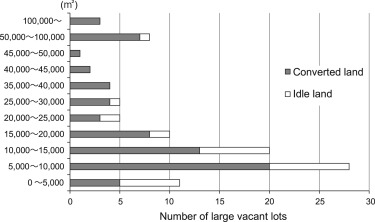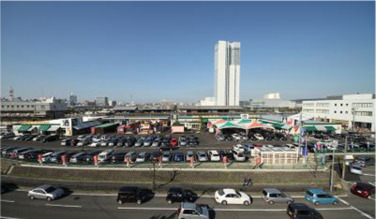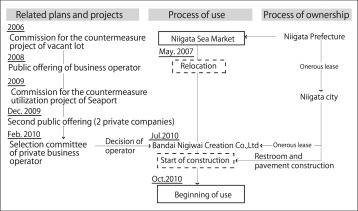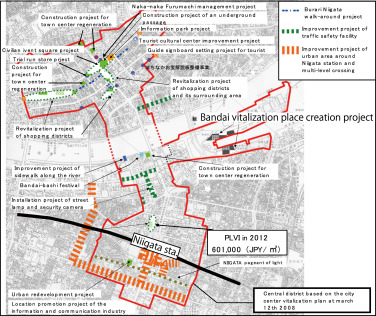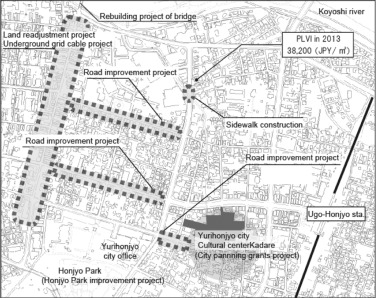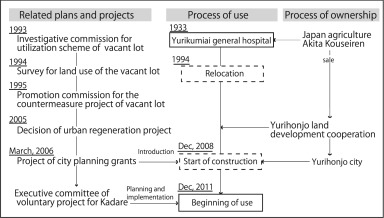Abstract
In Japan, local cities experience a number of problems related to deterioration of residential environment, quality of public service, and vitalization of commercial land. Specifically, the presence of large vacant lots behind sizable stores, office buildings, hospitals, and factories devitalize urban activity and its landscape. Many local cities are seeking to actualize a sustainable compact city with an integrated population, commerce, traffic and other public services in ways that promote a low carbon and energy-conserving society. Against the backdrop of these issues, this study examines the occurrence of large vacant lots and their utilization by local governments in Japan based on a questionnaire and field survey. It highlights several cases in which a large vacant lot is used to forward the development of a compact city by a local government.
Keywords
Large vacant lot ; Central district ; Urban regeneration ; Land use conversion ; Compact city
1. Introduction
For decades, local cities in Japan have experienced a hollowing-out problem. Since the 2016 revision of the “three town development laws,” including the City Planning Act, the Act on the Measures by Large-Scale Retail Stores for the Preservation of the Living Environment, and the Law on the Improvement and Vitalization of the City Center, government policies have moved toward promoting a “walkable compact sustainable city” in which workplaces and public services are in relative proximity to the homes of employees (Architecture Institute of Japan, 2015 ). Despite these laws, the number of fragile lands and vacant buildings used are increasing (Ohgai and Emoto, 2004 ). They function as disincentives for urban regeneration (Setoguchi et al., 2004 ). In particular, a large- scale vacant lot from an abandoned, extensive retail store or factory or caused by the relocation of a public facility to the suburbs can exacerbate the hollowing-out problem (Asano, 2002 ). The presence of these vacant spaces affects the future planning associated with the development of a compact city. Although large vacant lots exist in various parts of Japan, an overview of the effect of these lots has yet to be presented (Sakai, 2014 ).
2. Research method
First, the generation status of vacant lots and the associated trend in central districts are described based on a questionnaire survey aimed at investigating the actual conditions in 423 municipalities.
Second, according to the opinion of experts, several examples of utilizing vacant lots for realizing a compact city are selected. Then, the utilization method of large vacant lot from information about the background from generation to conversion, project method, ownership relationship, and usage situation are organized.
In this study, the conditions used to determine a “large vacant lot” are as follows: 1) the total site area is over 0.5 ha; and 2) it is located within 1 km from the nearest peak land-value intersection. From the results of the questionnaire survey, large vacant lots are classified into two types: land that has already been converted for other usages (hereafter referred to as converted land) and land that has not been converted yet (hereafter referred to as idle land).
3. Generation situation of large vacant lots in local cities
In 2013, the Regional Planning Committee of the Architectural Institute of Japan sent out a questionnaire to the departments of urban planning in 423 municipalities.
Municipalities in the three major metropolitan areas and three prefectures devastated by the Great East Japan Earthquake were removed from the list of our target group. The question items are shown in Table 1 . Answers from 239 municipalities were obtained; of those, 97 restated that they have vacant lots to meet the condition of this study (Table 2 ).
|
|---|
|
|
|
| Quantity of responses | Ratio (%) | Appropriate | N/A | Answer impossible | Non-respondent | |
|---|---|---|---|---|---|---|
| Hokkaido | 16/39 | 41.0 | 7 | 8 | 1 | 23 |
| Tohoku (Niigata) | 29/48 | 59.2 | 18 | 11 | 0 | 19 |
| Kanto | 28/44 | 63.6 | 9 | 19 | 0 | 16 |
| Tokai, Koushin | 42/70 | 60.0 | 21 | 21 | 0 | 28 |
| Hokuriku, Kinki | 30/68 | 44.1 | 12 | 18 | 0 | 38 |
| Chugoku, Shikoku | 48/65 | 73.8 | 17 | 30 | 1 | 17 |
| Kyushu, Okinawa | 46/89 | 51.7 | 13 | 32 | 1 | 43 |
| Total | 239/423 | 56.5 | 97 | 139 | 3 | 184 |
The total number of large vacant lot is 178. The number of lots categorized as converted land and idle land are 97 each (Table 3 ). Regionally, the largest number of lots by group, 44 (24.7%), is in the Tohoku Region (including Niigata Prefecture). The second largest number, 35 (19.7%), is in the Tokai and Koushin Regions.
| Converted land | Idle land | Total | ||||
|---|---|---|---|---|---|---|
| Number | Ratio (%) | Number | Ratio (%) | Number | Ratio (%) | |
| Hokkaido | 5 | 2.8 | 13 | 7.3 | 18 | 10.1 |
| Tohoku (Niigata) | 27 | 15.2 | 17 | 9.6 | 44 | 24.7 |
| Kanto | 2 | 1.1 | 9 | 5.1 | 11 | 6.2 |
| Tokai, Koushin | 17 | 9.6 | 18 | 10.1 | 35 | 19.7 |
| Hokuriku, Kinki | 12 | 6.7 | 9 | 5.1 | 21 | 11.8 |
| Chugoku, Shikoku | 18 | 10.1 | 9 | 5.1 | 27 | 15.2 |
| Kyushu, Okinawa | 8 | 4.5 | 14 | 7.9 | 22 | 12.4 |
| Total | 89 | 50.0 | 89 | 50.0 | 178 | 100.0 |
Regarding site space, the largest number of lots, 27, measure 5000–10,000 m2 (Fig. 1 ).
|
|
|
Fig. 1. Number of converted land and idle land by area. |
4. Typical use of large vacant lots
The features of lots categorized as converted land are discussed in this section. Since May 31, 2013, according to land and facility use, 18 (20.2%) are for commerce or business, while 16 (18.0%) are historical or cultural facilities (Table 4 ). The other uses include medical, welfare, and residential.
| Land and facility use | Number | Ratio (%) |
|---|---|---|
| Historical or cultural | 16 | 18 |
| Medical or welfare | 9 | 10.1 |
| Commercial or business | 19 | 21.3 |
| Public service | 8 | 9 |
| Other | 37 | 41.6 |
| Total | 89 | 100 |
4.1. Project owner and method
Table 5 shows the project implementing body. The city office has the largest number of projects, with 42 (47.2%). Second, retailers have five projects (5.6%), and associations for urban redevelopment have four (4.5%). In case of public projects, such as urban redevelopment, land readjustment, and urban regeneration improvement projects, the term tends to be within 5 years.
| Project body and client | Number | Ratio (%) |
|---|---|---|
| Retailer | 5 | 5.6 |
| Association for urban redevelopment project | 4 | 4.5 |
| City government | 42 | 47.2 |
| Other | 28 | 31.5 |
| No answer | 10 | 11.2 |
| Total | 89 | 100 |
4.2. Ownership transfer and utilization form of vacant land
Table 6 ; Table 7 presents the process of ownership transfer and the utilization form of converted land, respectively. Regarding ownership transfer, in 13 cases (14.6%), a land development corporation bought the land from the Japanese National Railways Settlement Corporation. Afterward, city governments eventually bought the land. At present, 18 lands (20.2%) are owned by city governments, and six (6.7%) of them are owned by governments for an entire term.
| Before | Interim period | After | Number | Ratio (%) |
|---|---|---|---|---|
| A | C | D | 13 | 14.6 |
| A | D | D | 2 | 2.2 |
| A | D | E | 1 | 1.1 |
| A | E+D | E+D | 1 | 1.1 |
| A | K | K | 1 | 1.1 |
| Subtotal | 18 | 20.2 | ||
| B | C | C | 1 | 1.1 |
| B | B | B | 1 | 1.1 |
| B | D | D | 2 | 2.2 |
| B | E+D | E+D | 1 | 1.1 |
| Subtotal | 5 | 5.6 | ||
| D | D | D | 6 | 6.7 |
| D | C | D | 1 | 1.1 |
| D | B | B | 1 | 1.1 |
| D | K | K | 1 | 1.1 |
| Subtotal | 9 | 10.1 | ||
| Other | 57 | 64.0 | ||
| Total | 89 | 100.0 | ||
A: Old Japan National Railways B: Private sector.
C: Land development cooperation D: City government.
E: Prefectural government K: Other.
| Before | Interim period | After | Number | Ratio (%) |
|---|---|---|---|---|
| A | H | H | 2 | 2.2 |
| A | C | C | 1 | 1.1 |
| A | O | O | 1 | 1.1 |
| A | O | H | 1 | 1.1 |
| A | K | K | 12 | 13.5 |
| Subtotal | 17 | 19.1 | ||
| F | H | H | 2 | 2.2 |
| F | C | C | 2 | 2.2 |
| F | S | S | 1 | 1.1 |
| F | B | B | 5 | 5.6 |
| F | P | P | 2 | 2.2 |
| F | P | S | 2 | 2.2 |
| F | P | K | 1 | 1.1 |
| F | O | O | 1 | 1.1 |
| F | O | S | 2 | 2.2 |
| F | O | C | 1 | 1.1 |
| F | O | O | 1 | 1.1 |
| F | O | K | 1 | 1.1 |
| F | K | K | 1 | 1.1 |
| Subtotal | 22 | 24.7 | ||
| Other | 50 | 56.2 | ||
| Total | 89 | 100.0 | ||
A: Switchyard of Old Japan National Railways
B: Housing lot C: Cultural center F: Factory H: Hospital
O: Parking P: Park S: Commercial facility K: Other.
Based on the utilization change form, 12 cases (13.5%) are converted from railway land to other usages (e.g., a civic center). Five cases (5.6%) of lands are converted to housing areas from factory use.
5. Utilization of large vacant lands for compact cities
Based on the opinions offered by researchers, governors, and consultant companies, 25 cases were selected for a case study used to analyze the utilization of large vacant lands for compact cities (Table 8 ).
| Municipal government | Facility use | Population (year)/Area of central district | Site area (Square meter) | Project Cost (JPY) | Project term | Former use | Background of generation of vacant land | Owner | Project | |
|---|---|---|---|---|---|---|---|---|---|---|
| Hokkaido | Otaru | Hotel, shop, house | 14,455/180 | 3560 | 6.5 billion | 2006–2009 | Commercial complex | Shutdown of principal tenant | Individual and Private company | Urban redevelopment project |
| Asahikawa | Welfare center for the disabled | 11,896/382 | 7100 | 103 billion | 2001–2014 | Switchyard | Business construction of Old Japan National Railways | Asahikawa City | Land readjustment Project | |
| Aomori | Aomori | Facility for tourism exchange | 3547/116.7 | 13,012 | 4998 million | 2006–2010 | Parking for bus | Redevelopment | Aomori City | Urban regeneration improvement project, cultural tourism exchange facility construction project |
| Hachinohe | Facility for multidiscipline exchange | 4540/108 | 17,300 | 1834 million | 2005–2007 | Civilian hospital | Redevelopment | Hachinohe City | Memorial park for annexation construction project | |
| Akita | Akita | Condominium building, large scale retail store, museum, interaction facility | 3381/119 | 17,365 | 135 billion | 2000–2012 | Japanese Red Cross and Women’s hall | Redevelopment | Private company | Urban redevelopment project |
| Yurihonjo | Combined cultural center | 7529 (2005)/119 | 13,335 | 77.1 billion | 2006–2010 | General hospital | Redevelopment | Yurihonjo City | Urban regeneration project | |
| Yokote | Branch government office, elderly housing, shopping center, parking, park | 5140 (2002)/107 | 6218 | 63 billion | 2006–2010 | General hospital | Redevelopment | Individual and Private company | Urban redevelopment project | |
| Yamagata | Nanyo | Assembly house, exhibition hall, comprehensive park | 18,415/290 | 6348 | 6.6 billion | 2001–2003 | Agricultural warehouse | Closing of Warehouse | Nanyo City | Preserving and utilization project of agricultural warehouse |
| Tochigi | Otawara | Comprehensive park | 3104/90 | 16,000 | – | 2009–2014 | Factory for Japan Tobacco, Inc. | – | Otawara City | Urban redevelopment project |
| Niigata | Niigata | Civilian market | 16,295 (2011)/261 | 9522 | 6.6 − 12.1 billion | 2006–2010 | Niigata Fish market | Redevelopment | Niigata Pref. | Fixed-term lease |
| Nagaoka | Municipal housing for sufferer, city park, fire headquarters | 5521 (2008)/90.5 | 115,000 | 120 billion | 2006–2011 | Switchyard | Business construction of Old Japan National Railways | Nagaoka City | Municipal housing for sufferer project, civilian disaster-prevention park project | |
| Tokamachi | Museum | 4372 (2012)/100 | 18,754 | 70 billion | 1999–2003 | Filature | Closing of factory | Regional Secretariat Division | Stage construction project | |
| Shibata | Hospital | 12,709 (2000)/240 | 57,000 | 99.5 billion | 2001–2006 | Filature | Closing of factory | Niigata Pref. | – | |
| Kashiwazaki | Municipal housing for sufferer, assembly house, nursing home | 6897 (2008)/193 | 12,540 | – | 2008–2009 | Factory for wood processing | Closing of factory | Kashiwazaki City | Municipal housing for sufferer project, local housing grant system | |
| Nagano | Ueda | Large-scale retail store, facility for cultural exchange, police office, house | 16,189 (2000)/185 | 192,000 | – | 2008–2011 | Factory for Japan Tobacco, Inc. | Closing of factory | Private company, Ueda City, Nagano Pref. | Land readjustment project |
| Toyama | Toyama | Community center, comprehensive park, super market | 24,099 (2006)/436 | 13,583 | 2.6 billion | 2010–2012 | Elementary school | Consolidation and relocation | Toyama City | Utilization project of vacant lot of Shimizu Elementary School |
| Ishikawa | Kanazawa | Museum | 73,292 (2005)/860 | 26,964 | 191 billion | 1995–2004 | Kindergarten, elementary school, junior high school | Relocation of schools | Kanazawa City | – |
| Komatsu | Museum of science | 14,270/167 | 17,190 | suspense for non-completion | 2012–2013 | Factory | Closing of factory | Komatsu City | Urban regeneration project | |
| Fukui | Tsuruga | Interaction facility, station square, laboratory, park, parking lot for bicycle and car | 9068 (2012)/178.6 | 47,416 | 37.5 billion | 2007–2016 | JR related facility | Closing of factory | Tsuruga City | Land readjustment Project |
| Shizuoka | Numazu | Conference center, exhibition hall, interaction facility, parking, hotel, condominium building | 22,357/227 | 21,959 | – | 2005–2013 | Switchyard | Tentative use of previous facility | Numazu City, Shizuoka Pref. | Livelihood and bustle revitalization project |
| Aichi | Toyohashi | Facility for interregional interchange | 8443/103 | 7516 | – | 2010–2013 | Cargo base | privatization | Toyohashi City | Arts and culture center construction project |
| Okayama | Kurashiki | Large scale retail store, disaster-prevention park | 8076/175 | 63,400 | – | 2010–2011 | Spinning factory | Closing of factory and entertainment park | Private company, Kurashiki City | – |
| Tottori | Yonago | Large scale retail store, convention center, parking | 11,342/300 | 16,000 | – | 1986–2008 | Hospital | Relocation | Yonago City, Tottori Pref., land development corporation | Land readjustment project |
| Miyazaki | Miyazaki | Traffic complex facility | 7575/162 | 10,600 | 47 billion | 2010–2011 | Switchyard | Tentative use of previous facility | Specific purpose company | Traffic complex center construction project |
| Saito | Parking | 8594/33 | 5063 | – | – | Railway station | Business construction of Old Japan National Railways | Saito City | Public parking project | |
These converted projects are all positioned as projects for the vitalization of the central district by various administrative plans, including the Plan for City Center Vitalization by the local government.
5.1. Utilization form of vacant land
These cases are organized based on the process, from generation to conversion, project method, ownership transfer, and utilization form.
The JT Ueda factory in Ueda city has the largest scale facility at 192,000 m2 . Based on the utilization form before conversion, eight sites were for a factory, five were for a switchyard of Old Japan National Railway, and four were for a hospital or welfare. Based on the utilization form after the conversion, many sites are complex facilities. In particular, 15 (31.0%) cases are in a complex with historical, cultural, or interaction facility (Table 9 ). Twelve (25.0%) cases are for commerce or business, and seven (15.0%) cases are for residential facilities. Public restoration housing was constructed in the cities of Kashiwazaki and Nagaoka, whereas elderly housing was constructed in the cities of Yokote and Akita. Using an entire area of vacant lot as land for facilities is difficult because vacant lots converted from switchyards owned by Old Japan Railways and factories have large site areas. In many cases, governments try to increase the number of visitors to the central district by constructing a comprehensive park and exchange facility. For example, in Kashiwazaki and Nagaoka, the public restoration housings that were constructed as part of the recovery from the Niigata Chuetsu Earthquake and the Niigataken Chuetsu-oki Earthquake in 2007 have been used for increasing the residential population of the central district. These conversions adopt the utilization form for compact town development that places homes and workplaces in closer proximity to each other.
| Land and facility use | Number | Ratio (%) |
|---|---|---|
| Historical or cultural | 15 | 31.3 |
| Medical or welfare | 2 | 4.2 |
| Commercial or business | 12 | 25.0 |
| Residence | 7 | 14.6 |
| Park | 3 | 6.3 |
| Traffic facility | 4 | 8.3 |
| Other | 5 | 10.4 |
| Total | 48 | 100.0 |
5.2. Owners of vacant lands
City governments are the most common owner of vacant lots as evidenced by 11 cases (55.0%). Typically, city governments own the vacant lots. Landowners establish companies to buy vacant lots in Akita, and city governments and private companies jointly own them in Ueda. In certain cases, city governments buy vacant lots from the private sector or the Japan National Railways Settlement Company. City or prefectural governments bought a switchyard from the Old Japan Railways. In case of Niigata City, the relocation of Niigata fish market was planned. The prefectural government loaned the site to the Niigata City Government for 10 years.
Afterward, the Niigata City Government invited the public to use the vacant lot. They loaned it to the selected company for the same cost that was paid to the Niigata Prefectural Government (Fig. 2 , Fig. 3 ; Fig. 4 ). This case is an example of how the vitality and know-how of the private sector can be used for regional regeneration while retaining their rights to vacant lots. In all cases, the owner is the government except in the cases of Otaru, Akita, Yokote, and Miyazaki.
|
|
|
Fig. 2. Project at Pier Bandai. |
|
|
|
Fig. 3. Utilization of vacant lots in Niigata. |
|
|
|
Fig. 4. Location of Pier Bandai and other projects in Niigata. |
5.3. Feature of conversion project
The most common managing body is the city government with 10 cases (50.0%) (Table 10 ). Five cases (20.0%) are managed by private companies and associations for urban redevelopment projects (Table 11 ).
| Project body and client | Number | Ratio (%) |
|---|---|---|
| City government | 13 | 52.0 |
| Prefectural government | 1 | 4.0 |
| Private sector | 2 | 8.0 |
| City government, prefectural government, private sector | 1 | 4.0 |
| City government, national government, private sector | 3 | 12.0 |
| Association for urban redevelopment project | 1 | 4.0 |
| No answer | 4 | 16.0 |
| Total | 25 | 100.0 |
| Project method | Number | Ratio (%) |
|---|---|---|
| Urban regeneration improvement project | 3 | 10.3 |
| Urban redevelopment | 4 | 13.8 |
| Tourism exchange facility construction project | 3 | 10.3 |
| Municipal housing for the disabled project | 2 | 6.9 |
| Land readjustment project | 4 | 13.8 |
| Regional residence grant project | 1 | 3.4 |
| Other | 9 | 31.0 |
| No answer | 3 | 10.3 |
| Total | 29 | 100.0 |
Urban Regeneration Improvement Project, Urban Redevelopment Project, and Interaction Facility Improvement Project are involved in three cases (13.0%). Regarding the time required completing a project (i.e., project term), projects can be finished within 5 years. After the establishment of a committee for planning the utilization of a vacant lot, 10 years are often required to start construction (Table 3 ).
5.4. Utilization
In a number of cases, the vacant lots of medical and welfare facilities were converted into parks. In several cases, a vacant lot of a factory was converted into a cultural or interaction facility. In the cities of Akita and Yurihonjo, vacant lots were used temporarily for an event or parking for town visitors until construction. These projects involved a later management and volunteer group. Therefore, one of the important factors for the successful conversion of vacant lots is the promotion of facility management after construction utilization (Fig. 5 ; Fig. 6 ).
|
|
|
Fig. 5. Location of Kadare and other projects in Yurihonjo. |
|
|
|
Fig. 6. Utilization of vacant lot in Yurihonjo. |
Twenty-five cases were selected as cases in which parking lots were utilized in an effort to develop compact cities. Many of them were vacant lots of railway land owned by the Old Japan National Railways, hospitals, factories, and public facilities. These lands were developed by a land readjustment and urban redevelopment project. These projects were subsidized programs under the law.
In the 25 cases selected by experts, the government participated in the conversion projects as landowner, building owner, or project body. In many cases, they participated as a landowner, and they employed a private company to manage their facility using the designated manager system.
Location near the city center or a large site area is the reason why projects and managements are difficult when large vacant lots are converted from a factory and a switchyard without government participation.
Regarding utilization after conversion, a larger number of facilities were used for civic exchange than as commercial and business facilities. In the cases of Kashiwazaki and Nagaoka, public restoration housings were constructed to increase in the residential population of the central district. The results indicate that the large vacant lots that were converted for compact town development were approached based on the concept of urban regeneration under government management.
6. Conclusion
The features related to the utilization of vacant lots can be described as follows:
- From the results of questionnaire survey about information on the division of development and improvement of municipal government, 178 vacant lots are found in 97 cities, and 89 of these sites were converted land that had already been used for other utilization form.
- Twenty-five cases were selected in which vacant lots were utilized for compact city development. Many of them were vacant lots of railway land owned by Old Japan National Railways, hospitals, factories, and public facilities. Only the lot in Otaru City was used for commerce.
For example, a land readjustment project was often executed in vacant lots on railway land in the cities of Asahikawa and Fukui. However, the utilization prior to the conversion had minimal effect on how it was used afterward.
Depending on the relationship with the present owner, a public complex facility was often constructed in cases where the landowner was the city or prefectural government.
Nevertheless, the following cases were also observed.
In Niigata, a private company is using a site owned by the government based on a fix-term leasehold. In Shibata City, a hospital and educational facility related to medicine and surgery were constructed.
If the landowner was an individual or someone in the private sector, a housing or commercial facility was often constructed as a cultural interaction property (for example, Akita, Yokote, and Numazu). In this research, we introduced the utilization method of vacant lots used for compact city development based on government policy from the viewpoint of the process from generation to conversion and in terms of ownership and utilization form. Different situations were observed regarding the timing of the appearance and the process in each municipality.
For the 25 cases we selected in this research, the municipal government related the vacant lot use before starting the project and positioned it as a part of an urban improvement project by Plan for City Center Vitalization.
These cases are used as a strategy for supporting future urban regeneration by local governments.
From these observations, we concluded that the generation of large vacant lots temporarily reduces the unifying force of a city in the built-up area.
The conversion of vacant lots, especially in local cities, can serve as seeds allowing urban forms to develop in ways that support a city׳s medium- and long-term vision and strategy. Earlier prediction of the generation of large vacant lots and sharing the image of their utilization with the landowner and its users are effective means of supporting urban regeneration that also offers an ideal public service.
Notes
- The built-up area of the Suburban Development Areas in Kinki region, Urban Improvement Areas, Urban Development Areas and Natural Reserve Areas in Chubu Region, and the Suburban Development and Redevelopment Areas in the National Capital Region were eliminated from the investigated municipalities.
Acknowledgements
We wish to acknowledge all the efforts of and guidance provided by the members of the regional machizukuri subcommittees, the Urban Regeneration subcommittee, and the person in charge of the Department of Urban Development and Improvement in each of the 423 municipalities. In particular, we would like to thank the following people: Assoc. Prof. Shu Higuchi, Nagaoka University of Technology; Motomu Ishimaru, NTT DATA Institute of Management Co., Ltd.; Toshihiro Ishimura, Land Brain Co., Ltd.; Toshiki Kobayashi, the Institute of Land Management; Assoc. Prof. Satoko Cho, Niigata Institute of Technology; Prof. Naomi Uchida, School of Economy, Saitama University; Prof. Shinji Nojima, Fukui University; Prof. Junichirou Asano, Toyohashi University of Technology; Assoc. Prof. Akira Uchida, The University of Kitakyushu; Prof. Bunpei Nakade, Nagaoka University of Technology: Prof. Tsuyoshi Setoguchi, Faculty of Engineering, Hokkaido University; and Megumi Takenoyama, Fukken Co., Ltd.
References
- Architecture Institute of Japan, 2015 Architecture Institute of Japan; Reorganization of Public Facilities—Guide of a Plan and the Practical-. Tokyo; Morikita Publishing (2015)
- Asano, 2002 J. Asano; A Study on the actual conditions of big shopping stores׳ closing and the tendency of its uses after the closing in the central areas of local cities: from researches on municipalities in Hokuriku-Koshin-Etsu area; J. Archit. Plan. (557) (2002), pp. 257–264
- Ohgai and Emoto, 2004 A. Ohgai, A. Emoto; A study on the land use awareness of land and building owners in the central district in Toyohashi City; AIJ J. Technol. Des. (24) (2004), pp. 371–376
- Sakai, 2014 A. Sakai; Trends in vacant Lot generation and utilization problems, and future problems; Jpn. J. Real. Estate Sci., 28 (3) (2014), pp. 17–23
- Setoguchi et al., 2004 T. Setoguchi, et al.; A Case Study on Planning the Urban Axis and Urban Core in terms of the Relationship Between the Downtown and the Harbor Distraction Wakkanai City Revitalization Program; AIJ J. Technol. Des. (20) (2004), pp. 261–266
Document information
Published on 12/05/17
Submitted on 12/05/17
Licence: Other
Share this document
Keywords
claim authorship
Are you one of the authors of this document?
